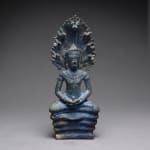Khmer Bronze Sculpture of Buddha Seated on Naga, 13th Century CE
Bronze
25.1 x 10.2 cm
9 7/8 x 4 in
9 7/8 x 4 in
X.0235
Further images
The Khmer civilization, today embodied by the temples and ruins of Angkor, one of mankind's most astonishing and enduring architectural achievements, flourished from 802-1431 A.D. From the great citadel of...
The Khmer civilization, today embodied by the temples and ruins of Angkor, one of mankind's most astonishing and enduring architectural achievements, flourished from 802-1431 A.D. From the great citadel of Angkor, the kings of the Khmer empire ruled over a vast domain that reached from what is now southern Vietnam to Yunan, China and from Vietnam westward to the Bay of Bengal. The original city was built around the Phnom Bakeng, a temple on a hill symbolizing the mountain that stands in the center of the world according to Hindu cosmology. Successive kings enlarged the city, building other temples devoted to various Hindu deities and large reservoirs used for irrigation, which also symbolized the ocean surrounding the holy central mountain.
Buddhist works of art such as this beautiful bronze Buddha often have symbolic elements that relate to the very early stages in the development of this highly complex religion. Elements of nature were an integral part of the early religions of India. The roots of Buddhism formed an alliance with these ancient popular cults of the soil and nature, including nature-spirits. In this example, the bronze Buddha sits on the coiled body of a Naga, the ancient Indian spirit of water that takes the form of a cobra. As the head of the snake forms a dramatic nimbus around the upper portion of the Buddha, individual serpent heads frame the Buddha's expressive face. The Buddhist religion spread throughout the east and nowhere is the artistic rendering of this spiritual religion more expressive than in the 12th and 13th century Khmer culture of Cambodia. This bronze Buddha illustrates the unique artistic craftsmanship of the Khmer. It is boldly expressive in form yet delicate in its sensibility. Graceful and powerful at once, the combined images of Buddha and Naga capture both the aesthetic and spiritual elements of our soul.
Buddhist works of art such as this beautiful bronze Buddha often have symbolic elements that relate to the very early stages in the development of this highly complex religion. Elements of nature were an integral part of the early religions of India. The roots of Buddhism formed an alliance with these ancient popular cults of the soil and nature, including nature-spirits. In this example, the bronze Buddha sits on the coiled body of a Naga, the ancient Indian spirit of water that takes the form of a cobra. As the head of the snake forms a dramatic nimbus around the upper portion of the Buddha, individual serpent heads frame the Buddha's expressive face. The Buddhist religion spread throughout the east and nowhere is the artistic rendering of this spiritual religion more expressive than in the 12th and 13th century Khmer culture of Cambodia. This bronze Buddha illustrates the unique artistic craftsmanship of the Khmer. It is boldly expressive in form yet delicate in its sensibility. Graceful and powerful at once, the combined images of Buddha and Naga capture both the aesthetic and spiritual elements of our soul.







